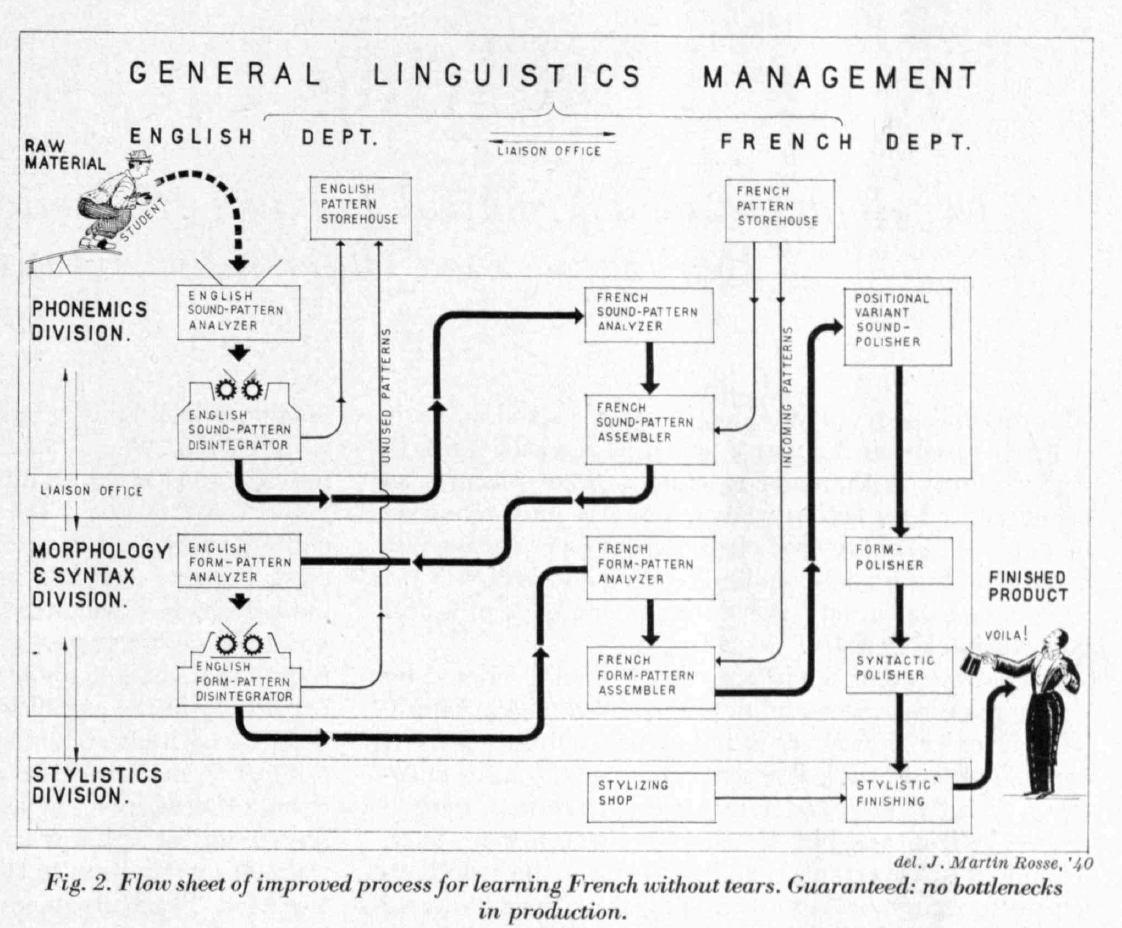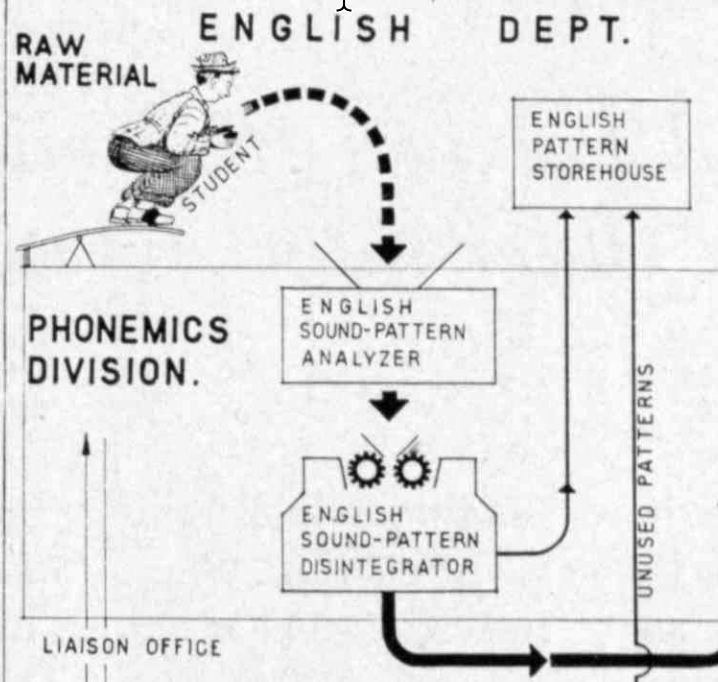Charlie Chaplin in French class
« previous post | next post »
In addition to a proto-regular-expression for English monosyllables, Benjamin Lee Whorf's 12/1940 Technology Review article has a weird diagram showing how a linguist (?) would organize French language instruction along the lines of mid-20th-century factory work:

The student preparing to dive through the "English Sound-Pattern Analyzer", into the "English Sound-Pattern Disintegrator", evokes Charlie Chaplin in Modern Times, at least for me:
I wonder whether Whorf had the same idea in mind? It seems likely, since Modern Times came out in 1936.
The caption's guarantee of "No bottlenecks in production" certainly reminds me of the lectures our foreman used to deliver during my part-time college job in an ice-cream-cone factory…
There are other aspects of Modern Times that could be taken as metaphors for (certain kinds of) language instruction:


Bill Benzon said,
November 28, 2023 @ 9:34 am
Hmmm…. I'm thinking maybe that first diagram was a reject from the mid-1970s ARPA Speech Understanding Project. And the Chaplain clip, that's obviously "A Dummy's Guide to GPT."
Robert Coren said,
November 28, 2023 @ 10:18 am
And of course it's later in the same film that Chaplin sings improvised French-sounding gibberish.
Mark Liberman said,
November 28, 2023 @ 10:55 am
@Robert Coren: "And of course it's later in the same film that Chaplin sings improvised French-sounding gibberish."
Indeed — though it seems half-way between Italian and French to me:
https://www.youtube.com/watch?v=0daS_SDCT_U&t=46s
Roscoe said,
November 28, 2023 @ 11:25 am
Shades of Rube Goldberg as well…
Tom S. Fox said,
November 28, 2023 @ 12:13 pm
I’m starting to believe fire prevention engineers don’t know anything about linguistics.
Benjamin E. Orsatti said,
November 28, 2023 @ 12:23 pm
Roscoe,
Sort of, but I'd always thought "Rube Goldberg" was an eponym for a schematic (or machine) that does something needlessly complicated to perform a very simple task. E.g., you don't necessarily need a bag of marbles, a housecat, a waterslide, a car battery, and a set of dominoes to turn off a light switch, but if you wanted to use all of those things, here's how you might do it.
Is there a word for taking something that normally doesn't lend itself to a schematic "work flow" diagram, like language instruction, and making such a schematic for it? If not, this is a linguistics blog, someone kick in and give us one!
Philip Taylor said,
November 28, 2023 @ 1:39 pm
Well, what you (plural) on the far side of the Atlantic know as "Rube Goldberg", we on this side know as "Emett", as in "an Emett machine".
Jerry Packard said,
November 28, 2023 @ 3:08 pm
What a great figure. It seems to assume a model where the L1 goes directly into L2 without translation, if you think about it. So, e.g., there is no reference to a lexicon/word list.
AntC said,
November 28, 2023 @ 4:06 pm
we on this side know as …
Do 'we'? I always knew them as Heath Robinson machines — indeed that entry explicitly compares to Rube Goldberg.
Emett machines are rather more whimsical sculptures with no practical purpose. (Yes I did see them at the Merrion centre when I lived in Leeds.)
cameron said,
November 28, 2023 @ 4:27 pm
I agree with AntC, above
Heath Robinson is the British figure analogous to Rube Goldberg.
the Emett machines are really cool, but not the same kind of thing
Benjamin E. Orsatti said,
November 28, 2023 @ 6:13 pm
For some reason it seems to me that an American looking at an "Emmet Machine" would call it "steampunk". I'm not sure what defines "steampunk" (and I'm not about to spoil that pristine ignorance with Wikipedia), but if I had to guess, I'd say it involves really big contraptions that aren't allowed to use circuitry or internal combustion engines.
Per the website, an Emmett Machine is "designed to help people do things which were impossible to do", whereas (maybe?) Rube Goldberg or Heath Robinson machines seem like they are designed to explode extremely possible tasks into gloriously intricate whimsy.
Arun said,
November 28, 2023 @ 6:58 pm
Not to take a cartoon too seriously, but it may be of interest to know that traditional Sanskrit grammar takes an opposite approach. There, the user starts with a specific vivakṣā (speaking intent) that then conditions the appearance of morphemes that conform with that intent. After this step, the user then inserts various āgamas (I think these would be called either augments or bound morphemes, in Western terms), followed by several rounds of "phonetic finishing" for accent and sandhi changes.
Jerry Packard said,
November 29, 2023 @ 8:23 am
@Arun
That’s the standard psycholinguistic model of speech production (e.g. Levelt), where the speaker starts with a ‘message.’